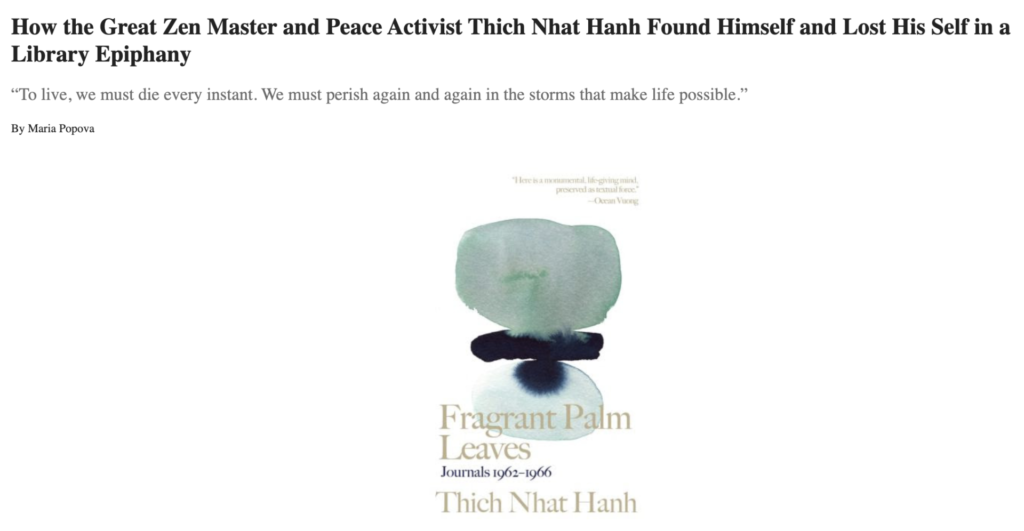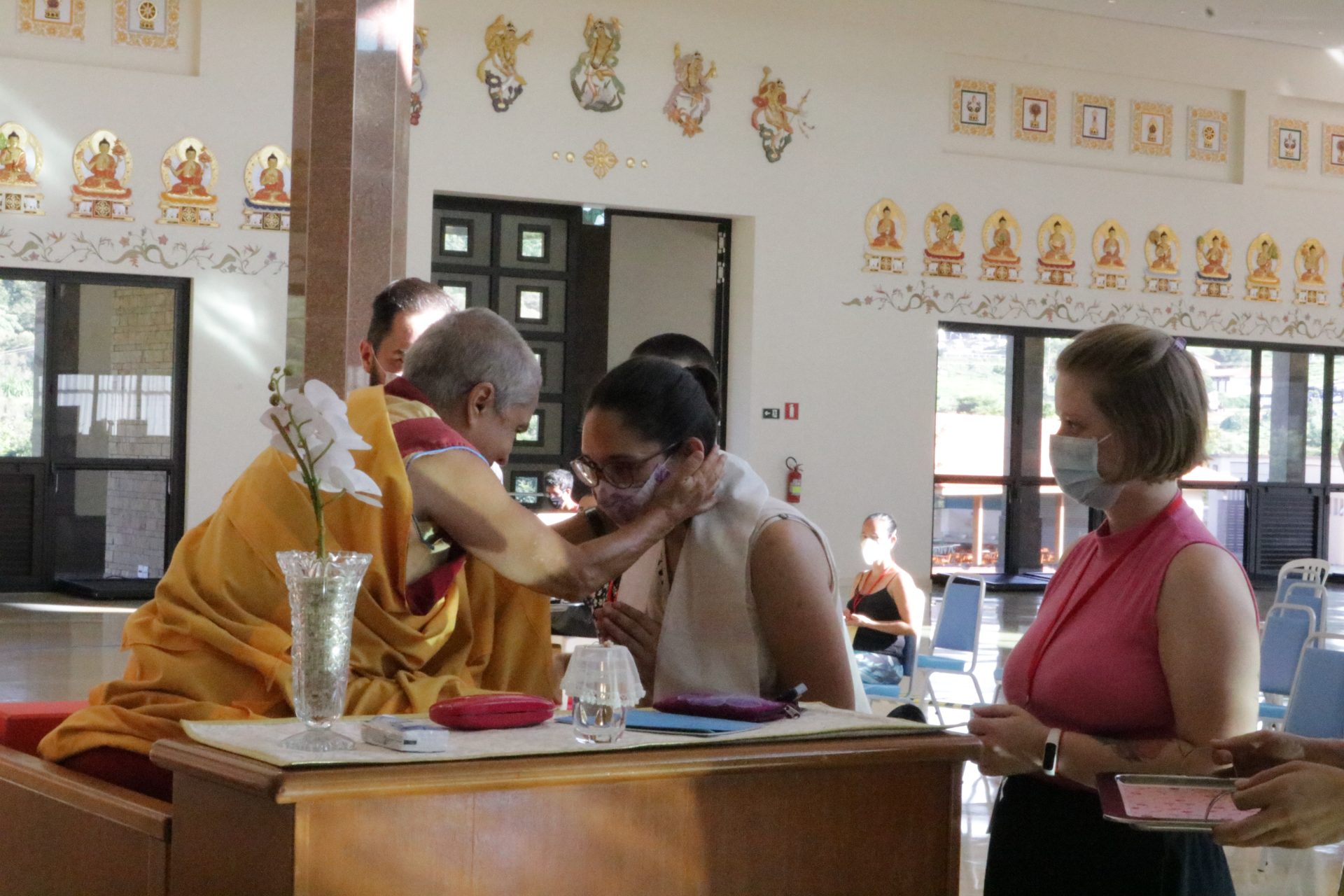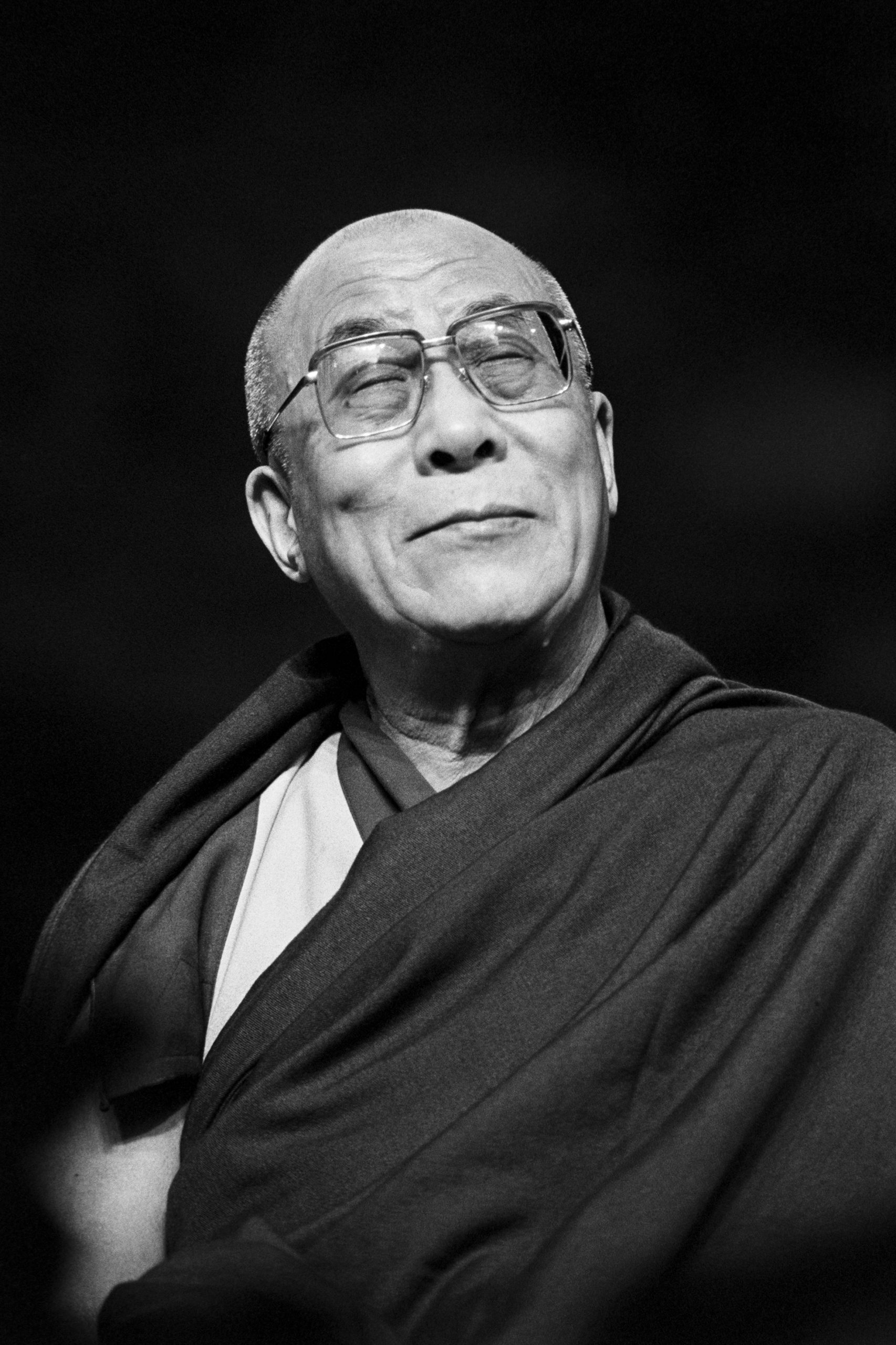Make Your Practice a Continuous Stream
A lesson in disenchantment from one of the Thai Forest Tradition’s most influential teachers The post Make Your Practice a Continuous Stream appeared first on Tricycle: The Buddhist Review.

When it comes to the dhamma, we have to understand that our opinions are one thing, the dhamma is something else.
Start out by establishing your powers of endurance and then contemplate. Contemplate your activities, your comings and goings. Contemplate what you’re up to. Whatever arises, the Buddha has us know it all around. If we know all around, whatever comes at us from this way, we see it. Whatever comes at us from that way, we see it. Right we know. Wrong we know. Happy we know. Glad we know. We know all around.
But our minds, when they contemplate, aren’t yet all around. We know just this side but leave that side wide open. It’s like putting a fence around a field or a house but it doesn’t go all around. If we put it up just on this side, thieves will come on that side, the side that the fence hasn’t gone around. Why is that? We haven’t closed the gate. So we contemplate again, adding more fence, closing things off, continually.
Putting up a fence means establishing mindfulness and always being alert. If we do this, the dhamma won’t go anywhere else. It’ll come right here. Good and bad, the dhamma we should see and should know will arise right here. As for whatever we don’t need to know, we let it go for the time being.
Your moods and preoccupations are one thing, the mind is something else. They’re two different kinds of things. Usually, when a mood hits, one that we like, we go running after it. If it’s one we don’t like, we turn our backs on it. When this is the case, we don’t see our own mind. We just keep running after our moods. The mood is the mood; the mind is the mind. You have to separate them out to see what the mind is like, what the mood is like.
As when we’re sitting here still, we feel at ease. But if someone comes along and insults us, we go running after the mood. We’ve left our spot. The mind gets deluded by the mood and goes running after it. When we do this we become a moody person—a person who panders to his moods.
You have to understand that all your moods are lies.
The world is our moods, our preoccupations. Our preoccupations are the world. If we aren’t acquainted with the dhamma, aren’t acquainted with the mind, aren’t acquainted with our preoccupations, we grab on to the mind and its preoccupations and get them all mixed up. It’s like you have many minds, and they’re all in turmoil. You don’t have many minds. You have many moods and preoccupations.
Your moods and preoccupations are one thing, the mind is something else.
The Buddha taught us to look at things right there, right where they arise. When they arise, they don’t stay. They disband. The Buddha taught us first to see these things all around, from all sides. Only then will the mind really be quiet and still. As long as we don’t know these things, as long as we don’t understand our moods, we become a moody person. We lay claim to our moods. This turns into stubbornness and pride.
Preoccupations change. They’re not constant or sure, they’re not stable. They just keep following their nature. The Buddha taught us to see that that’s the way they are. Whatever arises is just old stuff coming back.
When the mind is quiet, the Buddha tells us not to be intoxicated by it. When it’s distracted, he tells us not to be intoxicated by it. Things happen in all kinds of ways.
Stillness of mind—tranquility—comes from being far away from preoccupations. If you don’t hear much of anything, the mind settles down and is still. As long as you stay there, it’s quiet. But when it comes out to look at sights and hear sounds, that’s the end of it. It’s not at its ease anymore.
The Buddha wanted us to see sights, hear sounds, smell aromas, taste flavors, or touch tactile sensations: hot, cold, hard, soft. He wanted us to be acquainted with everything. He told us to give rise to discernment.
How do we give rise to discernment? The Buddha said that it’s not hard—if we keep at it. When distractions arise: “Oh. It’s not for sure. It’s inconstant.” When the mind is still, don’t say, “Oh. It’s really nice and still.” That too isn’t for sure.
Suppose that you like a certain kind of food and you say, “Boy, do I really like this food!” Try eating it every day. How many months could you keep it up? It won’t be too long before you say, “Enough. I’m sick and tired of this.” Understand? “I’m really sick and tired of this.” You’re sick and tired of what you liked.
We depend on change in order to live, so just acquaint yourself with the fact that it’s all inconstant. Pleasure isn’t for sure; pain isn’t for sure; happiness isn’t for sure; stillness isn’t for sure; distraction isn’t for sure. Whatever arises, you should tell it: “Don’t try to fool me. You’re not for sure.” That way everything loses its value. If you can think in that way, it’s really good.
To put it simply, that’s the Buddha. “Whoever sees the dhamma, sees the Buddha.” If you see the inconstancy of each and every thing, you give rise to nibbida: disenchantment. When you can do that, it’s no longer hard to contemplate. Whatever the preoccupation, you can say in your mind, “No big deal,” and it stops right there. Everything becomes empty and in vain: everything that’s unsteady, inconstant. It moves around and changes. It’s inconstant, stressful, and not-self. It’s not for sure.
It’s like a piece of iron that’s been heated until it’s red and glowing: Does it have any spot where it’s cool? Try touching it. If you touch it on top, it’s hot. If you touch it underneath, it’s hot. If you touch it on the sides, it’s hot. Why is it hot? Because the whole thing is a piece of red-hot iron. That’s the way it is. When that’s the way it is, we don’t have to go touching it. We know it’s hot. So you just stop touching it. “This is inconstant. That’s inconstant.” Nothing at all is for sure.
Even our thoughts are inconstant. Why are they inconstant? They’re not-self. They’re not ours. They have to be the way they are. They’re unstable and inconstant. Boil everything down to that.
Like this glass: It’s really pretty. You want to put it away so that it doesn’t break. But it’s not for sure. One day you put it right next to yourself and then, when you reach for something, you hit it by mistake. It falls to the floor and breaks. It’s not for sure. If it doesn’t break today, it’ll break tomorrow. If it doesn’t break tomorrow, it’ll break the next day—for it’s breakable. We’re taught not to place our trust in things like this, because they’re inconstant.
Things that are inconstant: the Buddha taught that they’re the truth. If you see that there’s no truth to things, that’s the truth. That’s constant. When there’s birth, there has to be aging, illness, and death. That’s something constant and for sure.
How is it constant? It’s constant in that that’s the way things keep on being. Even if you try to get in the way, you don’t have an effect. Things just keep on being that way. They arise and then they disband, disband and then arise. That’s the way it is with inconstancy. That’s how it becomes the truth. The Buddha and his noble disciples awakened because of inconstant things.
If you see that there’s no truth to things, that’s the truth. That’s constant.
When you see inconstancy, the result is nibbida. Disenchantment isn’t disgust, you know. If you feel disgust, that’s wrong, the wrong kind of disenchantment. The Buddha’s disenchantment is something else: leaving things alone, putting them down. You don’t kill them, you don’t beat them, you don’t punish them, you’re not nice to them. You just put them down. Everything.
The problems that we get involved with and cling to will gradually unravel. As the Buddha said, see simply that things arise and then disband, disband and then arise, arise and then disband. Keep watching this dhamma constantly, doing it constantly, developing it constantly, cultivating it constantly, and you’ll arrive at a sense of disenchantment. Disenchanted with what? Disenchanted with everything of every sort.
The things that come by way of the ears, we already understand them; by way of the eyes, we already understand them; by way of the nose, we already understand them; by way of the tongue, we already understand them. The things that arise in the mind, we already understand them. They’re all the same sort of thing—all of them, the same sort of thing: eko dhammo, one dhamma. This dhamma is inconstant, stressful, and not-self. You shouldn’t cling to anything at all. That way, disenchantment will arise. If the mind is peaceful and you feel, “Ah, it’s nice and peaceful,” the peace doesn’t matter either. Peace is inconstant too. There’s nothing but things that are inconstant. You can sit and watch the dhamma right there.
For this reason, if we gather things together as eko dhammo—one single dhamma—and see that their characteristics are all the same, it gives rise to disenchantment. This disenchantment isn’t disgust. The mind simply loosens its grip, it’s had enough, it’s empty, it’s sobered up. There’s no love, no hatred, no fixating on anything. If you have things, OK. If you don’t, it’s still OK. You’re at ease. At peace.
Nibbanam paramam sukham
Nibbanam paramam suññam
Nibbana is the ultimate happiness. Nibbana is the ultimate peace, emptiness. Listen carefully. Worldly happiness isn’t the ultimate happiness. Worldly emptiness isn’t the ultimate emptiness. The ultimate emptiness is empty of clinging. The ultimate happiness is peace. There’s peace and then there’s emptiness, the ultimate emptiness. At the moment, though, the mind is at peace, but it’s not ultimate. It’s happy, but it’s not ultimate.
This is why the Buddha described nibbana as the ultimate emptiness, its happiness as the ultimate happiness. It changes the nature of happiness to be at peace. It’s happy but not fixated on any object. The objects we like and don’t like are equal to each other.
The reason we live in physical seclusion (kaya-viveka) is to get the mind in mental seclusion (citta-viveka) from the objects that stir up its moods. These things are synonyms that follow one after the other. Upadhi-viveka refers to seclusion from our defilements: when we know what’s what, we can pull out of them; we pull out from whatever state the mind is in.
The Buddha taught us to live in the wilderness. The proper way, when a monk goes into the wilderness, is to stay in a quiet place; to wander in the quiet wilderness; not to be entangled with friends and companions and other sorts of things. That’s the right way to do it. But most of us don’t follow the right way. We live in a quiet place and get attached to the quiet. As soon as we see a form, it gives rise to defilement. In our ears there’s nothing but defilement. That’s going too far. It lacks discernment.
Make the mind know the dhamma. When it knows the dhamma, make it see the dhamma. Practice the dhamma so that the mind is dhamma. The strategies you’ll need will grow from within the mind. Whoever has discernment gains intuitive knowledge. Whoever has intuitive knowledge gains discernment. That’s the way it is.
I once read in a Jataka tale about our Buddha when he was still a bodhisattva. He was like you: he had ordained and encountered a lot of difficulties, but when he thought of disrobing, he was ashamed of what other people would think—that he had ordained all these years and yet still wanted to disrobe. Still, things didn’t go the way he wanted, so he thought he’d leave. As he was about to leave, he came across a squirrel whose baby had been blown into the ocean by the wind. He saw the squirrel running down to the water and then back up again. He didn’t know what it was doing. It ran down to the water and stuck its tail in the water, and then ran up to the beach and shook out its tail. Then it ran down and stuck its tail in the water again. So he asked the squirrel, “What are you doing?”
“Oh, my baby has fallen into the water. I miss it, and I want to fetch it out.”
“How are you going to do that?”
“I’m going to use my tail to bail water out of the ocean until it’s dry so that I can fetch my baby out.”
“Oh, no. When will the ocean ever go dry?”
“That’s not the issue. This is the way it is with practice. You keep bailing out the water, bailing out the water, and don’t care whether it ever goes dry. When you’re going to be a Buddha, you can’t abandon your efforts.”
When the bodhisattva heard this, it flashed in his heart. He got up and pushed through with his efforts. He didn’t retreat. That’s how he became the Buddha.
It’s the same with us. Wherever things aren’t going well, that’s where they will go well. You make them happen where they aren’t yet happening. Wherever you’re deluded, that’s where knowledge will arise. If you don’t believe me, spit right here. That’ll make it dirty. But when you wipe it away, it’ll be clean right here—right where it’s dirty.
This is the practice. You contemplate right where you’re deluded so that you’ll know right there. Any other issue is just duck shit and chicken shit. You don’t have to go groping after it. That’s how you have to take things on in meditation.
But actually, it’s not a matter of taking. You take them on by abandoning them. This is how the suppositions of language have things all backwards. You let things go. You practice letting go.
Wherever you’re deluded, that’s where knowledge will arise.
Think about it in a simple way. If someone yells at you but you don’t rear up in response, that’s the end of the matter. It doesn’t reach you. But if you grab hold of it and won’t let go, you’re in bad shape. Why put their words into yourself? If they yell at you, just leave it at that. But if they yell at you over there in the ordination hall and you bring it into your ears while you’re sitting here, it’s as if you like to suffer. This is called not understanding suffering.
You need to have patience and endurance. You need to make an effort. Whatever happens, you don’t have to pick it up and carry it around. When things are a certain way, that’s all they are. When we see the dhamma in this way, we don’t hold on to anything. Pleasure we know. Pain we know.
The Buddha and his arahant disciples, when they gain awakening: It’s not the case that coconut-milk sweets aren’t sweet for them. They’re sweet in the same way they’re sweet for us. When the noble ones eat a sour tamarind, they squeeze their eyes shut just like us. Things are just the same way they were before, but the difference is simply that the noble ones don’t hold on to them or get fixated on them. If you argue with them that the tamarind is sour, they’ll say, “Sour is fine. Sweet is fine. Neither sour nor sweet is fine.”
It’s a matter of practice. You learn to be content with little. You learn a sense of moderation in eating, a sense of moderation in sleep. You don’t have to look elsewhere. You don’t have to read a lot of books. Watch your own mind. The basic principles lie right here. This way you can meditate without getting deluded.
If people speak to you in a way that grates on your ears, that makes you mad, tell yourself, “It’s not for sure. It’s inconstant.” If you eat something delicious and think, “Mmm. It’s really good,” remind yourself that it’s not for sure. Whatever comes your way, tell yourself, “It’s not for sure.” Why? Because that’s where the dhamma lies.
If you really see inconstancy, you see the dhamma. Why wouldn’t you see it?—for the truth lies right there. If you see the dhamma, you see the Buddha. These things go in both directions. When the dhamma is in charge, the mind is always aware of things. It knows that “This is wrong. This is right. This is good. This is evil. This is suffering. This is the cause of suffering. This is the disbanding of suffering. This is the practice that reaches the disbanding of suffering.”
That’s the path. Everything gathers into the path. As you strengthen the path, your defilements decrease. You stay only with what’s right. Whatever’s wrong, you give it up, give it all up, and the wrong path peters out.
That’s when the right path gets established, and you can live wherever you want. Gaining is the same as losing; losing, the same as gaining.
Pleasure isn’t the highest level of dhamma. It’s peace because it’s no longer disturbed by pleasure or pain. It’s empty. It stays unfixated, unattached. Wherever you go, it keeps staying that way.
For instance, if somebody’s mood comes to hit you—You know, venerable father, you’re just like a dog”—you stay at your ease. Once you’re sure of yourself, that’s the way it is. But if they call you a dog and you really become a dog, biting them, that shows you’re not sure of yourself. You’re not for sure. Once you’re for sure, you’re not anything.
For the most part, the good things are what lead people to be very deluded. They’re deluded by what’s good. When good isn’t just right, it’s not good, you know. Have you noticed the rainfall this year? It was so good that it went past just right, flooding people’s houses. This is what happens when good goes past just right.
The Buddha taught us to be intelligent.
In practicing, don’t think that you have to sit in order for it to be meditation, that you have to walk back and forth in order for it to be meditation. Don’t think like that. Meditation is simply a matter of practice. Whether you’re giving a sermon, sitting here listening, or going away from here, keep up the practice in your heart. Be alert to what’s proper and what’s not.
Ajahn Mun once said that we have to make our practice the shape of a circle. A circle never comes to an end. Keep it going continually. Keep the practice going continually without stop. I listened to him and I thought, “When I’ve finished listening to this talk, what should I do?”
The answer is to make your alertness akaliko: timeless. Make sure that the mind knows and sees what’s proper and what’s not, at all times.
It’s like the water in this kettle. If you tilt it so that there’s a long time between the drops—glug … glug—those are called water drops. If you tilt it a little farther, the drops become more frequent: glug-glug-glug. If you tilt it a little bit farther, the water flows in a stream. What does the stream of water come from? It comes from the drops of water. If they’re not continuous, they’re called drops of water.
The water here is like our awareness. If you accelerate your efforts, if your awareness is continuous, your mindfulness will become full. Both by day and by night, it’ll keep staying full like that. It becomes a stream of water. As we’re taught, the noble ones have continuous mindfulness. The water is a stream of water. Make your awareness continuous. Whenever there’s anything wrong or lacking in any way, you’ll know immediately. Your awareness will be a circle, all around. That’s the shape of the practice.
There’s nothing in the dhamma taught by the Buddha that lies beyond human capabilities. Don’t go focusing on things you can’t see: heaven or nibbana up there in the sky. All the dhammas we need to know and see, the Buddha explained in full. As for things you can’t see, don’t pay them any mind. Don’t pay them any attention. Look instead at the present. How are you leading your life? If suffering arises, why is there suffering? What’s going on? How can you settle the problem right there? What are you stuck on?
◆
Excerpted and adapted from Still, Flowing Water by Venerable Ajahn Chah. Translated from Thai by Thanissaro Bhikkhu © 2007, 2011, 2012, 2013, The Sangha, Wat Pah Nanachat, Warin Chamrap, Ubon Ratchathani 34310, Thailand.

 Koichiko
Koichiko 























![Are You Still Optimizing for Rankings? AI Search May Not Care. [Webinar] via @sejournal, @hethr_campbell](https://www.searchenginejournal.com/wp-content/uploads/2025/06/1-1-307.png)








